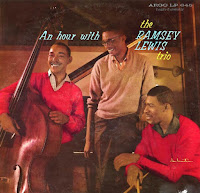Billy Taylor and His Orchestra - Taylor Made Jazz
Released 1959
Recording and Session Information
Billy Taylor and His OrchestraWillie Cook, Clark Terry, trumpets; Britt Woodman, trombone; Johnny Hodges (as The Rabbit), alto saxophone; Paul Gonsalves, tenor saxophone; Harry Carney, baritone saxophone; Billy Taylor, piano; Earl May, bass; Ed Thigpen, drums
Biddy's Beat
Theodora
Mood For Mendes
Daddy-O
Cu-Blu
Day Dreaming
Can You Tell By Looking At Me
Tune For Tex
Track Listing
| Biddy's Beat | Billy Taylor | 21141 |
| Theodora | Billy Taylor | 21141 |
| Mood For Mendes | Billy Taylor | 21141 |
| Daddy-O | Billy Taylor | 21141 |
| Cu-Blu | Billy Taylor | 21141 |
| Day Dreaming | Billy Taylor | 21141 |
| Can You Tell By Looking At Me | Billy Taylor | 21141 |
| Tune For Tex | Billy Taylor | 21141 |
Liner Notes
WHEN the Ellington sidemen spend their offstand hours recording outside the Duke's domain, they select their sessions with care. After all, they've got a reputation to uphold. The Ellington band, for years, has represented precise discipline, flawless taste, and an inimitable repertoire. Duke's men are generally unwilling to chip that stature by making sessions that don't reflect some of the charm and challenge of life with Ellington.Those musicians who have been a part of the urbane Ellington atmosphere can appreciate the virtues of the most professional jazzmen. That's why the Ellingtonians present here were eager to explore eight compositions by Billy Taylor, all arranged by bassist Johnnie Pate. Pianist Taylor writes moody, lyrical, elegant ballads, in the best, most lasting sense of the term uromantic." His medium and up-tempo compositions have a surging quality, without ever being frenetic; they are more than adequate inspiration for the soloing horn man. Taylor is a sophisticate and his music has a rich, contemporary flavor—modern and moving and free of faddistic cliches.
Clark Terry, Willie Cook, Harry Carney, Paul Gonsalves, and Britt Woodman need no introduction to such sopllistication. They know it on the grand Ellington level. And they are sensitive enough to relish Taylor-made adventures.
Taylor's presence on piano, of course, is indispensable. His playing is as melodic (and pianistic) as his compositions. Southpaw bassist Earl May has worked with Taylor for several years, as did drummer Ed Thigpen, currently serving as one of the rotors in Oscar Peterson's mainspring trio.
Compatibility, obviously, can be taken for granted here. Yet what is most impressive is the manner in which Taylor's tunes are performed—not in a perfunctory manner at all but, rather, with infinite insight and love.
There isn't a frantic or strident moment on any track in this LP. That's rare enough these days. What's comforting to the harassed jazz listener is the down-the-middle swing and the pointed, but never pretentious, ballad tours.
The ballads — Theodora, Mood For Mendes, Day Dreaming, and Can You Tell By Looking At Me — are superbly conceived and touchingly played (liner note prose is full of such terms, I admit, but in this case they were selected for accuracy rather than filler purposes).
It isn't unusual to hear jazz groups attacking fleetly-flowing riffs, but many jazzmen seem to be out of touch with the art of ballad interpretation. For a definitive sample of playing a ballad as a ballad, without any sense of urgency or rigidity, listen to "The Rabbit" and Taylor (with astute assists from May and Thigpen) on Theodora. It's an exquisite performance, lean of line yet directly moving. The same sort of approach makes the other ballads sincerely poignant experiences, too. For a change, the modern jazz listener can feel and fully accept the soloists' lyrical side.
The non-ballad material is equally tasteful, from the bounce of Biddy's Beat to the sprightly flavor of Daddy-O to the earthy Cu-Blu to the Longhornish prance, Tune For Tex. The soloists are at ease, the rhythm section is wholly compatible, and the tunes are delights. It's like the rare holiday gathering, with everyone contributing, but no one being a distracting bore.
This sort of maturity is a natural product of meaningful experience in jazz. The Ellington brigade comprises men who have enjoyed both security and growth in their tenure with the Duke; their lives and their music veer from the angry sounds of so many of today's young jazzmen. They've listened to jazz and absorbed it and reflect its better moments in their playing. Taylor has had a like background, playing with most of the greats of modern jazz. Such a union of forces couldn't have produced anything but the serenity and swing you hear in this set.
It's a Taylor-made session, all right. And it will wear well.
Don Gold
Assistant Editor
Playboy Magazine


















